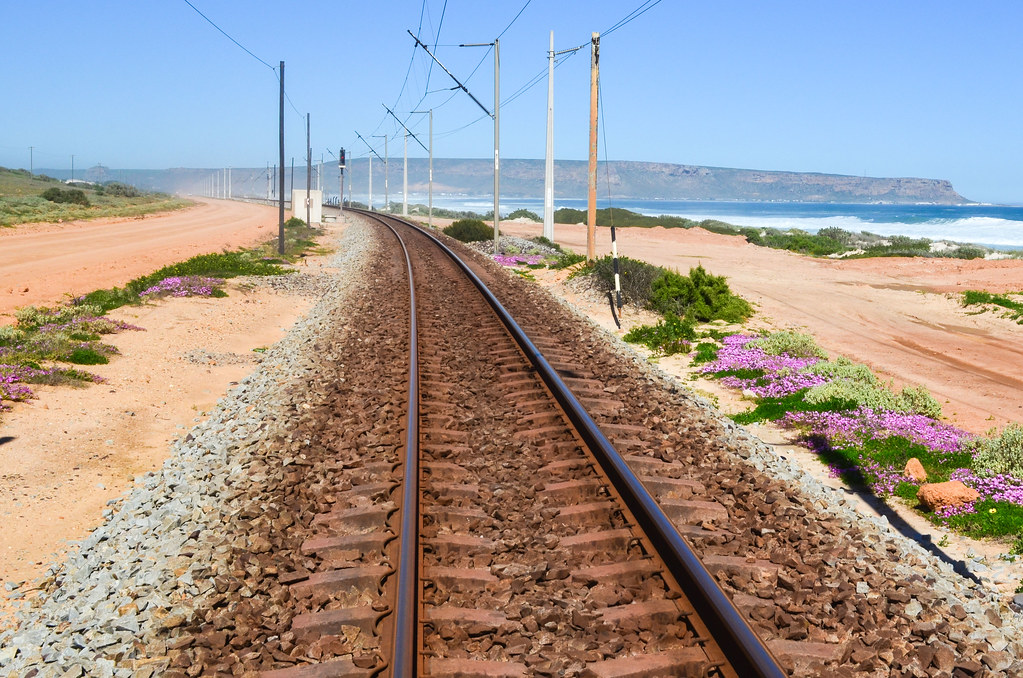Sishen–Saldanha railway line
The railway line Sishen - Saldanha ( Saldanha - Sishen English Railway Line), also Erzexportlinie ( Ore Export Line or Orex line ) is a 861 km long, single-track, electrified railway in South Africa.
The route connects iron ore mines near Sishen in the Northern Cape to the Atlantic port of Saldanha in the Western Cape Province. On their run heavy freight trains; Passenger does not occur. It was, as usual, built in South Africa in Cape gauge.
Geography
At an altitude of 1295 meters above sea level in Sishen the route rises to 42 kilometers long, before it falls off the Orange in Groblershoop out. Rises to the next 300 kilometers and falls the route until it falls off the Atlantic coast. The route crosses the Olifant 's River on a 1035 -meter-long viaduct between Vredendal and Lutzville, reached the coast and follows her around 160 kilometers south to Saldanha. The track has numerous curves with large radii. Run parallel to the track gravel roads. Roads to be crossed generally level free. The only tunnel is 840 meters long Bobbejaansberg tunnel near Elands Bay.
History
With a cabinet decision of February 1973, the South African government gave its approval for the expansion of mining activities in the region Sishen. This included the construction of a railway line and a bulk cargo port in Saldanha Bay. The legal bases for the two projects were the Sishen - Saldanha Bay Railway Construction Act (Act No. 28/1973 ) and the Saldanha Bay Harbour Construction Act (Act No. 29/1973 ). The decision to build evolved subsequently become a controversial topic, the debate has continued in the course of the year 1974 in the public and spreading to other major industrial centers such as Richards Bay and Newcastle. With the study on the feasibility of the railway line from Sishen to Saldanha dealt the Straszacker Committee, whose report was not published. The entire cost of building the railway, harbor and all ancillary facilities you quantified at this time to 480 million rand.
The railway line was built from June 1, 1973 by ISCOR (South African Iron and Steel Corporation ), a government- iron and steel companies, which promoted since 1953 in Sishen iron ore and for its removal was needed a powerful connection to the nearest deep water port. In May 1976 was opened the route; in April 1978 it was handed over to South African Railways & Harbours, today Transnet Freight Rail, which electrified the route. An operating voltage of 50 kV AC was chosen instead of the usual 25 kV in order to carry heavier loads and increase the distance between the substations can. At first there were the trains of three locomotives of the SAR Class 9E, which attracted 210 freight cars of the type CR with a capacity of 80 tons. Since 1978, iron ore from Beeshoek is traversed in Postmasburg. 1980 drove the first freight train carrying ore concentrate to the port Saldanha.
1989, the record of a train of nine electric locomotives, seven diesel locomotives and 660 loaded wagons took place. The train was 7303 feet long and weighed 71 210 tons. His average speed was around 38 km / h By 2008 600 million tons of ore were shipped. 2010 derailed the third and final segment of a train. 107 loaded with iron ore cars jumped off the rails, three locomotives were destroyed. In a similar accident in the same year an unoccupied train was derailed because the wireless connection was torn down to some of the unoccupied locomotives.
Originally the single track had been provided with ten crossing points (loops ). Since then the number increased to 19, to increase the link capacity. Loop 7 ( De Kop, at kilometer 337 ) is to be replaced by Loop 7A, which should be between kilometers 316 and 324, so that the distances between the points of intersection are more evenly.
Operation
The depot Salkor Yard is located in Saldanha, about five kilometers from the port. There, in the marshalling yard, the trains are divided into smaller units and down to the harbor. The maximum speed is 80 km / h
The iron ore trains are driven by two people, in Halfweg is a change of staff instead. Every week, about 30 iron ore trains. The intersection points are unoccupied except in Halfweg. Usually there waiting empty trains loaded on trains.
The ore trains are operated since 2007 with Radio Distributed Power technology ( RDP). They have a total mass of around 41,400 tons and are the longest bulk goods transported trains in the world. Your axle load is 30 tonnes of the world's highest at Cape gauge routes. The trains have a maximum of 342 wagons pulled by eight locomotives. The two of them are coupled, so that the cars are called in three sections, rakes, divided. Thus they reach a length of four kilometers. Each freight car can load 100 tons. Mainly electric locomotives of the class 9E and Class 34 diesel locomotives used, the latter in multiple traction locomotives with Class 9E. Since 2009 it also uses electric locomotives of Class 15E. In addition to the iron ore trains run shorter trains.
About three quarters of transporting cargo is iron ore. There are also other bulk commodities such as Zinkerzkonzentrat, salt, gypsum and coal. Since 1994, access by rail from a treatment plant in Koekenaap, coming through the branch route from the direction Bitterfontein concentrates with ilmenite, zircon and rutile to a smelting plant in Saldanha. Within the state rail company Transnet, the debt of the track forms a separate division and is called Orex ( for Ore export, German: Erzexport ) refers.
The track is the world's only electrified at 50 kV 50 Hz railway line. Next to her, exist in North America some more tracks that were electrified with 50 kV, including the Black Mesa and Lake Powell Railroad ( BM & LP).










